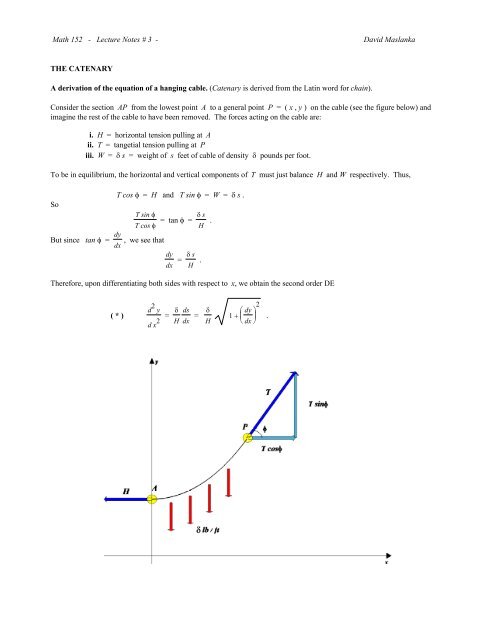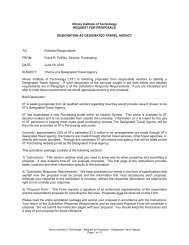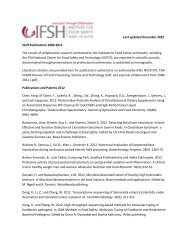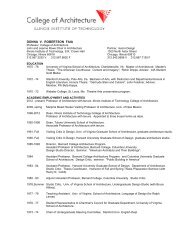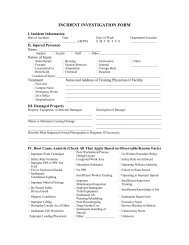Math 152 - Lecture Notes # 3 - David Maslanka THE CATENARY A ...
Math 152 - Lecture Notes # 3 - David Maslanka THE CATENARY A ...
Math 152 - Lecture Notes # 3 - David Maslanka THE CATENARY A ...
You also want an ePaper? Increase the reach of your titles
YUMPU automatically turns print PDFs into web optimized ePapers that Google loves.
<strong>Math</strong> <strong>152</strong> - <strong>Lecture</strong> <strong>Notes</strong> # 3 - <strong>David</strong> <strong>Maslanka</strong><br />
<strong>THE</strong> <strong>CATENARY</strong><br />
A derivation of the equation of a hanging cable. (Catenary is derived from the Latin word for chain).<br />
Consider the section AP from the lowest point A to a general point P = ( x , y ) on the cable (see the figure below) and<br />
imagine the rest of the cable to have been removed. The forces acting on the cable are:<br />
i. H = horizontal tension pulling at A<br />
ii. T = tangetial tension pulling at P<br />
iii. W = δ s = weight of s feet of cable of density δ pounds per foot.<br />
To be in equilibrium, the horizontal and vertical components of T must just balance H and W respectively. Thus,<br />
T cos φ = H and T sin φ = W = δ s .<br />
So<br />
T sin φ<br />
T cos φ = tan φ = δ s<br />
H .<br />
But since tan φ = dy<br />
dx , we see that dy<br />
dx = δ s<br />
H .<br />
Therefore, upon differentiating both sides with respect to x, we obtain the second order DE<br />
( * )<br />
d 2 y<br />
dx 2 = δ H<br />
ds<br />
dx = δ<br />
H<br />
1 +<br />
2<br />
⎛ dy ⎞<br />
⎜ ⎟<br />
⎝ dx ⎠<br />
.
Problem _______________________________________________________________________________________<br />
Show that y = a cosh ( x a ) + C satisfies the differential equation ( * ) with a = H δ<br />
by doing the following:<br />
1. Substitute z = dy<br />
dx<br />
and<br />
dz<br />
dx = d2 y<br />
dx 2 in ( * ) and obtain a first order DE with dependent variable z .<br />
2. Solve the first order DE in z .<br />
Hint: This involves verifying that:<br />
Then note that<br />
⌠<br />
⎮<br />
⌡<br />
1<br />
d<br />
1 + z 2 z = ln ( z + 1 + z z ) + C .<br />
ln ( z + 1 + z z ) = sinh -1 ( z ) , the inverse hyperbolic sine of z .<br />
3. Replace z in terms of y and solve the resulting first order DE for y .


